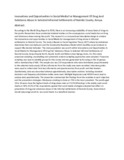| dc.contributor.author | Mutai, Christopher | |
| dc.contributor.author | Ombachi, Nicholas | |
| dc.contributor.author | Simiyu, Ruth | |
| dc.date.accessioned | 2021-12-14T11:52:24Z | |
| dc.date.available | 2021-12-14T11:52:24Z | |
| dc.date.issued | 2020-06-30 | |
| dc.identifier.uri | https://nacada.go.ke/sites/default/files/AJADA/AJADA%203/4.%20%20AJADA%203%20-%20Innovations%20and%20Opportunities%20In%20Social%20Media%20For%20Management%20Of%20Drug%20And%20Substance%20Abuse%20In%20Selected%20Informal%20Settlements%20of%20Nairobi%20County%2C%20Kenya.pdf | |
| dc.identifier.uri | http://ir-library.mmust.ac.ke:8080/xmlui/handle/123456789/1808 | |
| dc.description.abstract | According to the World Drug Report in
2016, there is an increasing availability
of many kinds of drugs to the youth.
Researchers have conducted minimal
studies on the consequences social media
has on Drug and Substance abuse
among the youth. This research is a crosssectional descriptive design to analyze the
innovations and opportunities in Social
Media for management of drug abuse in
informal settlements in Nairobi County. The
study is based on Social Cognitive Theory
(SCT) where by individuals determine
their own behavior and the Community
Readiness Model which modifies social
contexts to support the desired behavior.
The study population was youth within
Innovations and Opportunities In Social Media For
Management Of Drug And Substance Abuse In Selected
Informal Settlements of Nairobi County, Kenya
Kayole North, Kayole South and Mukuru
kwa Njenga slums. For this study purposive
sampling, snowballing and systematic
random sampling approaches were
adopted. Purposive sampling was used
to identify groups for the survey and was
generated by focusing on the 32 groups
with a membership of 460. The sample size
was 210 respondents who were distributed
proportionately to the selected study
area(s).30 key informants from the study
area were recruited. Interview guides were
used to collect data from key informants
and questionnaires from youth and their
leaders. Qualitatively, data was described
whereas quantitatively, descriptive statistics
including standard deviation and frequency
distribution tables were used. Multiple
Regression and ANOVA were used to
analyze data quantitatively. The researcher
summarized the findings from the variables
in each objective and the prevention
strategies. Marijuana smoking in slums at
73% is the most prevalent. The youth aged
18 to 24 years have the highest levels of
drug abuse rates at 73.5%.WhatsApp is the
widely used social media at 54%.23.2% of
the respondents agreed that social media
strategies adopted had effect on prevention
of drug and substance abuse in the informal
settlements of Nairobi County. Government
should encourage youth to use social media
in a beneficial manner. | en_US |
| dc.language.iso | en | en_US |
| dc.publisher | African Journall of Alcohol and Drug Abuse, | en_US |
| dc.subject | Innovations , Opportunities, Social, Media , Management , Drug ,Substance, Abuse, Selected, Informal, Settlements | en_US |
| dc.title | Innovations and opportunities in Social media for management of drug and substance Abuse in selected informal settlements of Nairobi County, Kenya | en_US |

